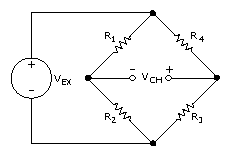Strain Gages
You can measure strain with a strain gage, which is a device with electrical resistance that varies in proportion to the amount of strain in the device, and with signal conditioning. When using a strain gage, you bond the strain gage to the device under test, apply force, and measure the strain by detecting changes in resistance (Ω). Strain gages return varying voltages in response to stress or vibrations in materials. Resistance changes in parts of the strain gage to indicate deformation of the material. Strain gages require excitation, generally voltage excitation, and linearization of the voltage measurements.
Strain measurements rarely involve quantities larger than a few microstrain (µε). Therefore, measuring strain requires accurate measurements of very small changes in resistance. For example, if a test specimen undergoes a substantial strain of 500 µε, a strain gage with a gage factor of 2 exhibits a change in electrical resistance of only 2 × (500 × 10 -6 ) = 0.1%. For 120 Ω, this is a change of only 0.12 Ω.
Wheatstone Bridges
To measure such small changes in resistance and to compensate for temperature sensitivity, strain gages often use a Wheatstone bridge configuration with a voltage or current excitation source. The general Wheatstone bridge, shown in the following figure, is a network of four resistive legs with an excitation voltage, VEX, that is applied across the bridge. One or more of these legs can be active sensing elements.

The Wheatstone bridge is the electrical equivalent of two parallel voltage divider circuits. R1 and R2 compose one voltage divider circuit, and R4 and R3 compose the second voltage divider circuit. You measure the output of a Wheatstone bridge between the middle nodes of the two voltage dividers.
A physical phenomena, such as a temperature shift or a change in strain applied to a specimen, changes the resistance of the sensing elements in the Wheatstone bridge. You can use the Wheatstone bridge configuration to help measure the small variations in resistance that the sensing elements produce corresponding to a physical change in the specimen.
Gage Factor
A fundamental parameter of the strain gage is its sensitivity to strain, expressed quantitatively as the gage factor (GF). Gage factor is the ratio of the fractional change in electrical resistance to the fractional change in length, or strain. The gage factor must be the same for each gage in the bridge.
The gage factor for metallic strain gages is usually around 2. You can obtain the actual gage factor of a particular strain gage from the sensor vendor or sensor documentation.
Nominal Gage Resistance
Nominal gage resistance is the resistance of a strain gage in an unstrained position. You can obtain the nominal gage resistance of a particular gage from the sensor vendor or sensor documentation. The resistance across each arm of the bridge must be the same for the bridge to be unstrained. For example, if you have two strain gages and two reference resistors, the gages must have the same nominal gage resistance, and the resistance of the reference resistors must be the same as the nominal gage resistance for the strain gages.
Types of Strain Gages
Strain-gage configurations are arranged as Wheatstone bridges. The gage is the collection of all of the active elements of the Wheatstone bridge. There are three types of strain-gage configurations: quarter-bridge, half-bridge, and full-bridge. The number of active element legs in the Wheatstone bridge determines the kind of bridge configuration.
| Configuration | Number of Active Elements |
|---|---|
| Quarter-bridge | 1 |
| Half-bridge | 2 |
| Full-bridge | 4 |
You can measure axial strain, bending strain, or both. While you can use some similar configuration types to measure torsional strain, NI software scaling does not support these configuration types. It is possible to use NI products to measure torsional strain, but to properly scale these configuration types you must create a custom scale. Refer to bridge configurations for more information on bridges.